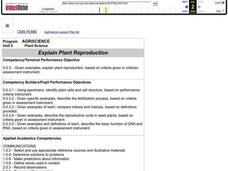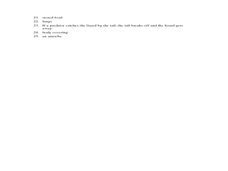Curated OER
Garden Grid
Basically, your class reads about different garden plants from an included handout and seed packets that you provide, and then uses a grid to plan out where to place the plants. They can practice counting with the seeds, grouping,...
Curated OER
3rd grade life science
In this life science activity, 3rd graders answer multiple choice questions about plants, birds, habitats, and more. Students complete 20 questions.
Curated OER
How Does Vegetation Decrease Erosion?
For this erosion worksheet, students will compare what happens to soil when water flows over soil with no vegetation and soil with vegetation. Then, students will complete four short answer questions.
Curated OER
"Lettuce" Learn About the Water Cycle
Young scientists investigate the water cycle through a lettuce seed experiment. For this experiment, learners plant lettuce seeds inside of a ziplock bag in order to create a small greenhouse. They observe condensation and precipitation,...
Captain Planet Foundation
Fall into Healthy Shapes
Kindergartners identify geometric shapes by planting a fall garden. They start their seeds in containers that have different shapes, and keep track of their plants based on those shapes. This brilliantly designed and incredibly thorough...
Curated OER
From Genes to Jeans
This unit of lessons is designed for 7th through 9th graders. They are introduced to the world of agriculture and the genetic research and various technologies that are associated with agriculture. Pupils work together to come up with a...
Georgia Department of Education
Living Things/ Nonliving Things
How can you tell if something is living or nonliving? Introduce a set of criteria which can be used to determine which things are alive and which are not. The class discusses the basic needs of all living organisms, checks out an...
Curated OER
Plant Parts And What They Do (5.2)
In this identifying plant parts and what they do worksheet, students answer multiple choice, true and false, and fill in the blanks with the best vocabulary words. Students write fifteen answers.
Curated OER
Speedy Succession
Fifth graders identify how a pond can change into a grassland. An ecosystems lesson where learners identify pioneer and climax species, and recognize that ecological succession can take up to 100 years or more. Some excellent activities...
Curated OER
Let's Sort a Salad
Students examine edible plants by identifying salad ingredients. In this botany lesson, students discuss the different vegetables that can be eaten in a salad and draw them on a worksheet. Students review vegetable vocabulary and examine...
Curated OER
Dig In - Grow your own grub
Students monitor the growth of a plant over several weeks. In this earth science lesson, students plant a courgette plant, take digital photos, and upload them to the BBC gallery. They turn their photos into live animation showing the...
Curated OER
4-H Horticulture/Garden Activity Page- Beginning
In this 4-H garden project worksheet set, student study the parts of seeds and plants. They make a mini-greenhouse. They complete a career scavenger hunt, tools word search, and experiment to learn more about the effect of water on seed...
Curated OER
The Ancient Cycads
For this cycads worksheet, students will read a short essay on the cycad tree, including it's reproductive strategies and it's general characteristics. Then students will complete 2 short answer questions based on what they read.
Curated OER
Water, Water, Everywhere and Always on the Move
Students create their own water cycle in a terrarium. In this water cycle lesson, students research the water cycle and complete a worksheet using the Internet. They create a water cycle of their own in a jar with stones, sand, soil, and...
Curated OER
Green Apples
Third graders brainstorm the effects of light on the growth of plants. In groups, they participate in various activities in which they grow alfalfa sprouts and lima beans. They complete a worksheet on how the varying amount of light...
Michigan Farm Bureau
The Little Red Hen
No one will be saying "Not I" with a lesson that combines The Little Red Hen with the life cycle of a wheat stem! After reading the story in your class, pass out wheat stems to your learners and have them examine the plants closely,...
Curated OER
The Living Environment
In this living environment worksheet, students complete a crossword puzzle given 34 clues about the various species in the environment that produce, consume and decompose. Topics also include photosynthesis, respiration, glucose, organic...
Curated OER
It's Just Dirt
Students discover how seed germination varies according to the soil type. For this soil science lesson, students discuss what plants need in order to grow and investigate various types of soil. Students use their senses to describe each...
Curated OER
Plant Reproduction
Students plant seeds in order to investigate and explore the questions: "How do seed companies develop varieties of plants?" and "What is the ideal plant?" Students will study related vocabulary and sketch seeds as they emerge. Students...
Curated OER
Fourth Grade Science
In this science worksheet, 4th graders answer multiple choice questions about natural objects, rainfall, the solar system, and more. Students complete 25 questions.
Curated OER
Fifth Grade Science Assessment
In this science assessment worksheet, students complete a 25 question multiple choice quiz about biology. Plant and animal anatomy is included.
Curated OER
Owls: Top of a Food Chain
Although written for middle schoolers, there is no reason that a 3rd, 4th, or 5th grader could not also learn about food chains through the dissection of owl pellets. After you introduce the topic, learners complete an owl research...
ARKive
Parts of the Plant
Every good lesson on plant life should have a good worksheet to go along with it. Here is a very nice worksheet that requires students to label the four main parts of a plant. Included is a second worksheet that shows three different...
The New York Times
Trouble in the Hive: Researching the Decimation of Honeybee Colonies
Teach your class about colony collapse disorder and foster discussion about causes and solutions for the honeybee problem. Class members read and discuss an article and participate in one of two detailed activities about pollination and...

























